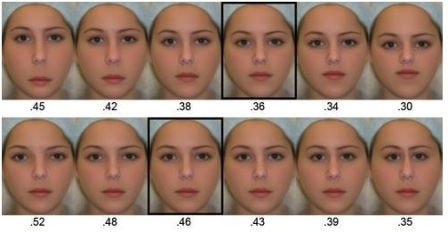Hindus have divided arts under 64 branches. An expert is expected to master all those subjects. A popular Tamil hymn is praising Goddess Saraswati as the one who bestows everyone with these 64 “arts”. One of them is the art of knowing the character of a man by studying his features. This is called Samudrika Lakshna. (some books drop one or two subjects and include certain others-only minor changes) There are several books giving more details about women’s body features. The books are called Anga Shastra. Vatsyayana , the author of Kamasutra, who lived two thousand years ago wrote in detail about the sexual organs. So that was purely a sexual classification of men and women.

Samudrika Lakshanam - Body Symmetry or Body Features
Tamils classified women in to seven categories according to their age: Pethai, Pethumbai, Mangai, Matanthai,Arivai, Therivai and Perilam Pen, starting from age 5 and finishing with 40. Probably they called over forty women with a general term like “woman”. Sanskrit book Rati Rahasya went one step further and classified women into four categories on the basis of psycho-physical aspects: Padmini, Chitrini, Shankini and Hastini. Many books were written until 12th century giving more information about women’s body features. All these show serious research was done in these areas by Hindus. I doubt any other ancient culture has done so much work on body features and characters.
Latest scientific research by westerners confirms our studies. Though they have not quoted our texts on these subjects their approach is same. This makes it an urgent necessity of studying our ancient scriptures and prove them scientifically. This will help us to diagnose even diseases well in advance.
If we could predict the character of a person in advance, we could even take corrective measures for people with bad characters. Following are the scientific studies which strengthens our beliefs:
- Back in 1977 the newspapers reported a new device developed by the Moscow Institute of Radio Engineering, Electronics and Automatics. The device is called thermovisor. The device was used for diagnosing diseases of thyroid (neck), the mammary glands (breast) and cardio vascular system (heart and blood vessels). Every object releases heat. There are parts in the human body where temperature exceeds the normal one. Such parts are situated around the eyes, the lips and on the forehead. The difference in temperatures is taken into account for diagnosis ( Tamils call snakes as Katsevi meaning EYE EAR. The eyes of snakes have got special organs which does the function of ear i.e. the snakes could see its prey during night time using infra red rays- body heat of the prey). This is about body heat and not about body features.
- By 2008 many books were published about the measurements of hands, particularly fingers. John Manning found out our fingers provide a wealth of evidence about how men and women differ and how they are programmed before birth to show certain behaviour patterns and likely hood of getting certain diseases . John Manning’s book The Finger Book explains, the length of our ring and index fingers can greatly influence our personality, health and abilities. The language and approach of the book is similar to Sanskrit books on Samudrika Lakshan, but differ in details.
- Another study by Michael Heselhuhn showed something more interesting. He found out that there is a link between a person’s behaviour and WHR. One’s WHR (width Height Ratio) is the ratio between face width and face height. His study involved 192 MBA students. The result of his study showed that men who have wider faces relative to their facial height are involved in un ethical behaviour. Michael is from Wisconsin University. He did this research along with Elaine M Wong.
- Back in 2009, The Science Daily reported another study proving a link between the eyes and the mouth. Pamela Pallet and Stephen Link of University of California and Kang Lee of the University of Toronto did four experiments and discovered golden ratios for beauty. They said the position of the eyes and the mouth decided the beauty of a person. This was also in line with samudrika Lakshan. They said that the value of Phi was known to Greeks as divine proportion. Some believe that Lerado Da Vinci used this proportion for painting the most famous Monalisa. In short they found out, if the vertical distance between their eyes and the mouth is approximately 36 percent of the face’s length and the horizontal between their eyes was approximately 46 percent of the face width they looked beautiful. Even if one doesn’t understand all these mathematics of beauty, one can understand that there is always a link between the body features and one’s own behaviour or attraction.
- Three researchers from the Psychology department of Brock University, Canada also concluded that facial features can tell us whether a person is aggressive or not.
- All these Western researchers did not study the books on Samudrika Lakshan. If we do some scientific research on available information from our scriptures we may throw more light on this art/science.
- In our literature we read about a person drawing a one’s whole figure just by looking at his or her nail. We also knew that great painters like Raja Ravi Varma did all Hindu Gods and goddesses by reading Sanskrit hymns. Those hymns were once again visualised by our seers. Heroines of Sanskrit literature drew the pictures of lovers by dreaming or hearing about him. It is a shame that we did not take all these writings worthy of scientific research.